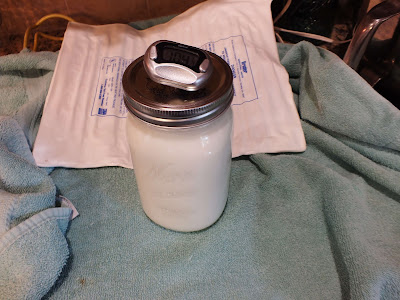I have been experimenting quite a bit lately with incorporating chocolate in breakfast pastries. There is no reason that chocolate cannot be a viable part of a special breakfast! This pastry is similar to my Pecan Praline Weave. I absolutely love that pastry, but I started wondering what else I could put in there. And I wondered what other types of dough recipes I could try. This is the result of that experimentation. I love how easy the dough is to make. It is easy to work with when the dough is cold and the filling is very chocolaty. The pastry is not overly sweet. It is rich and decadent, but not cloying in any way. I adore it!
I also love how easy it is to shape. It looks so amazing, you might be tempted to think it would be hard to put together, but it really isn't at all. Roll the dough out into either one large or two smaller rectangles. Use a pizza cutter to cut 1/2 - 3/4 inch wide strips along both edges of the long edges of the dough. It helps to imagine the dough as being folded in a tri-fold manner. Spread the filling down the middle third. To keep the pastry very pretty, I cut the last strip on each side on both ends off. This allows me to fold over the end of the middle third for a nice, well kept look.
Brush the pastry with egg wash and sprinkle with sanding sugar. They're completely optional, but I think the almonds add a certain je ne sais quoi. Another great thing about this bread is that it really doesn't need to sit to rise after the pastry is put together. This allows it to be easily made in the morning fairly quickly. I make the dough the night before and put it in the refrigerator. In the morning, I roll the dough out and put together the pastry. I then immediately put it in the oven, and thirty minutes later, I have chocolate pastry nirvana. Not bad!!
Hello, chocolate. How are you doing? Man, do I need more excuses to make this thing.
Chocolate Pastry Braid
Yield: Approx one 20x6 inch braid or two 10x6 inch braids
For the dough:
2/3 whole milk, lukewarm
5 TBS sugar
2 tsp instant yeast
2 large eggs
2 1/2 cups flour
1/2 tsp salt
1/2 cup (1 stick) salted butter, softened
1/2 cup flour
For the filling:
2/3 cup powdered sugar
1/4 unsweetened cocoa powder
4 ounces bittersweet chocolate
1/4 cup butter
2 TBS heavy cream
1 egg mixed with 1 TBS water
1/4 cup sanding sugar
sliced almonds (optional)
In a stand mixer, add all ingredients except for the final 1/2 cup of flour. Using the paddle attachment, mix until the dough is well mixed and fairly smooth. Switch to the dough hook, and while on speed 2, add the remaining flour. Let mixer knead the dough for 3-5 minutes, until it is very smooth. It will still be very sticky. Put into a greased container and cover tightly. This dough will easily double over night, so be sure to use a large enough container. Refrigerate overnight or at least 8 hours.
When ready to assemble the pastry, preheat the oven to 375 degrees F. Generously flour the counter and roll out the cold dough into one very large rectangle (or divide the dough in half and roll into two smaller rectangles). Consider transferring dough onto a piece of parchment (this helps transfer the finished pastry onto the baking sheet, especially if your kitchen is hot or you take a while to assemble the pastry). Place all filling ingredients into a microwave safe bowl. Heat gently in the microwave, stirring regularly, until the mixture is smooth. Spread evenly in the middle third (long ways) of the dough. Use a pizza cutter to cut the dough in 1/2 to 3/4 inch wide strips on each side of the middle third (see picture above). Remove the last strip on each side on both ends. Fold over the middle end of the dough on each end and then alternately lay the strips across the chocolate. Brush with egg wash and sprinkle liberally with sanding sugar. If desired, sprinkle with sliced almonds.
Immediately place in the preheated oven. Bake until puffed and golden, about 25-30 minutes. Let cool 10 minutes before slicing and serving. Keeps well, tightly covered, for 2-4 days.







































